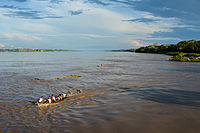
Photo from wikipedia
Abstract This work aims to evaluate the tolerance, growth, metabolism, hematology and blood biochemistry of juvenile Lophiosilurs alexandri exposed to different water salinities. In Experiment 1, juveniles (28.6 ± 1.3 g weight and… Click to show full abstract
Abstract This work aims to evaluate the tolerance, growth, metabolism, hematology and blood biochemistry of juvenile Lophiosilurs alexandri exposed to different water salinities. In Experiment 1, juveniles (28.6 ± 1.3 g weight and 12.8 ± 1.8 cm length) were transferred directly from freshwater to water with salinities of 0 (freshwater), 2.5, 5.0, 7.5, 10.0, 12.5 and 15.0 g of salt/L, and observed for 96 h. In Experiment 2, juveniles (15.5 ± 0.8 g weight and 11.0 ± 1.0 cm length) were subjected to saline treatments of 0 (freshwater), 2.5, 5.0, 7.5 and 10.0 g of salt/L for 28 days with, juveniles being acclimated gradually every 6 h, to reach the desired salinity levels in 24 h. In Experiment 1, at 24 h of osmotic shock, the CL 50 -24 h was estimated to be 11.6 g of salt/L. At the end of 96 h, the survival rate was 100% up to salinity 7.5 g of salt/L, while at 10.0 g of salt/L it was 58.3%. Total mortality occurred with 12.5 and 15 g of salt/L. At 24 h, changes in glucose, hemoglobin, osmolarity, hematocrit, cortisol, alanine aminotransferase and chloride ions were recorded. However, there were no significant differences in total plasmatic protein, triglycerides, cholesterol and albumin (p > 0.05). In Experiment 2, there was total mortality on the 21st day of the experiment with 10 g of salt/L. At 28 days, the survival rate was 100% between freshwater and 5 g of salt/L. In terms of biomass gain and feed conversion, a quadratic response with higher estimated levels at 2.01 and 2.45 g of salt/L were recorded, respectively. Weight gain, daily weight gain and specific growth rate were constant until the estimated values of 2.64, 2.63 and 2.83 g of salt/L, respectively, then decreasing in higher salinities. For whole fish composition, phosphorus and protein exhibited a quadratic response with the highest level estimated at 3.24 g of salt/L and the lowest estimated level at 0.98 g of salt/L, respectively. Constant values for energy were recorded until the estimated salinity at 2.15 g of salt/L. Comparing the hematological and biochemical data between 24 h and 28 days, several differences were found relating to time, salinity and the interaction between these factors, depending on the variable analyzed. Water salinity has direct implications for hematological, biochemical, performance and carcass composition of juvenile L. alexandri . Salinities up to 7.5 g salt/L for short time periods (96 h) to diseases treatments or transport and 2.5 g/L in longer time periods (28 days) to cultivation indoor can be used for juvenile L. alexandri .
Journal Title: Aquaculture
Year Published: 2017
Link to full text (if available)
Share on Social Media: Sign Up to like & get
recommendations!